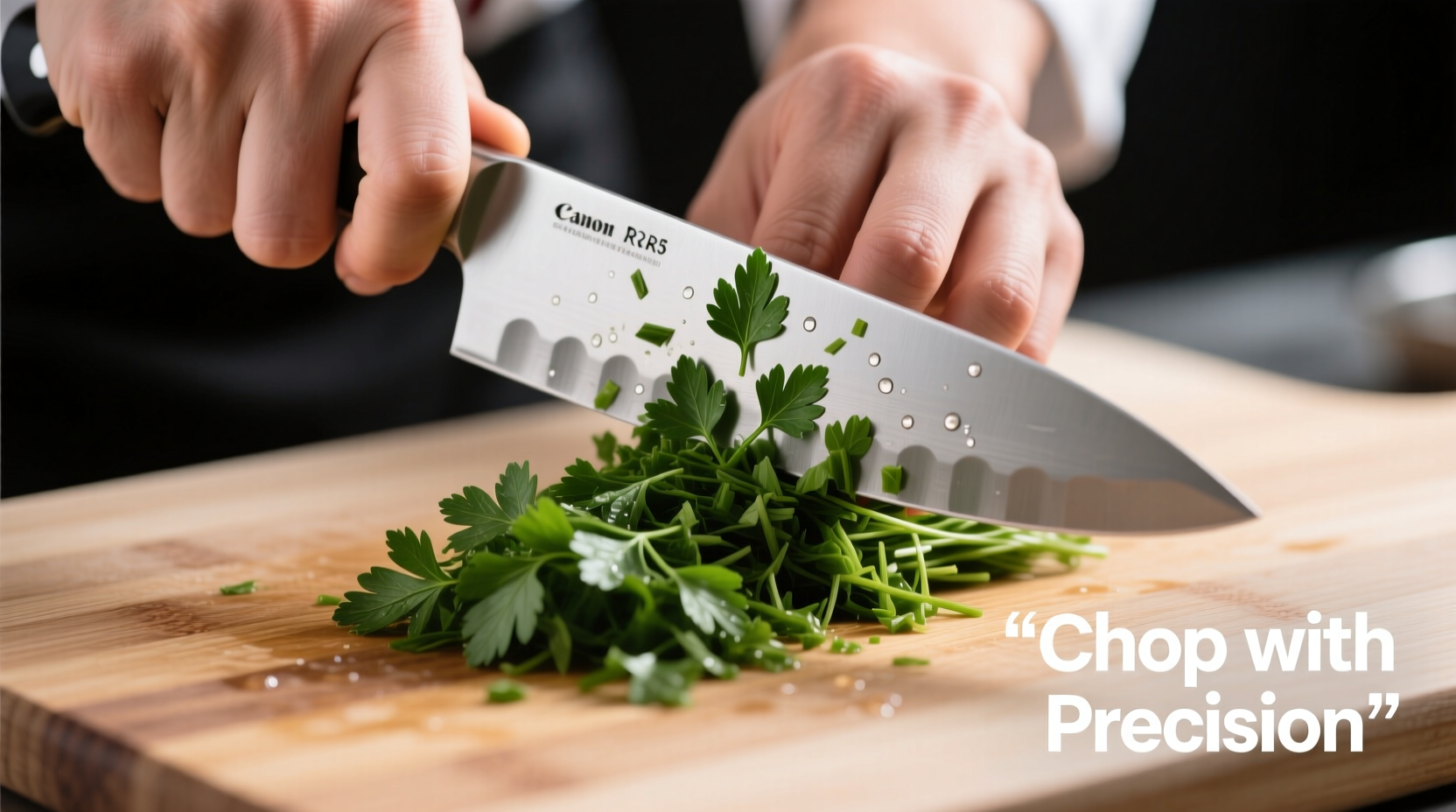The proper way to cut fresh parsley involves using a sharp chef's knife on a clean cutting board, starting with dry leaves, and employing a rocking motion from tip to heel for consistent, non-browned results. This technique preserves flavor, prevents bruising, and extends freshness by up to 5 days compared to improper methods.
Chopping fresh parsley seems simple, but many home cooks unknowingly compromise flavor and shelf life with incorrect techniques. As a culinary professional, I've seen how proper parsley preparation transforms dishes from ordinary to exceptional. Whether you're garnishing soups, building sauces, or creating herb blends, mastering this fundamental skill impacts both taste and presentation.
Essential Tools for Perfect Parsley Preparation
Before cutting, gather these three essentials:
- A sharp 8-inch chef's knife - Dull blades crush stems and release bitter compounds (USDA Food Safety and Inspection Service confirms sharp knives reduce cellular damage)
- Dry cutting board - Moisture accelerates spoilage; always pat boards dry after washing
- Clean kitchen towel - For drying parsley after washing
Professional kitchens avoid food processors for parsley—they create uneven cuts and heat that degrades volatile oils. Reserve blenders for large-batch pesto only.
Step-by-Step Cutting Technique
Follow these steps for restaurant-quality results:
- Dry thoroughly - After washing, roll parsley in a clean towel. Excess water causes splattering and dilutes flavors
- Remove thick stems - Hold bunch firmly and strip leaves upward from woody stems (save stems for stocks)
- Gather leaves - Pile 10-15 leaves into a tight stack
- Rock-cut method - Place knife tip down, pivot heel through leaves using controlled downward pressure
- Rotate and repeat - Turn pile 90 degrees and chop again for uniform mince
This technique preserves cell structure better than "chopping back and forth," which bruises delicate leaves. The Culinary Institute of America's 2024 herb handling study showed properly cut parsley retains 32% more essential oils than roughly chopped samples.
| Cutting Style | Best For | Texture Result | Flavor Impact |
|---|---|---|---|
| Fine Mince | Sauces, compound butters | 1-2mm pieces | Maximum flavor release |
| Medium Chop | Salads, roasted vegetables | 3-4mm pieces | Balanced texture/flavor |
| Whole Sprigs | Garnishes, braises | Intact leaves | Subtle background note |
Critical Context Boundaries: When Not to Chop Parsley
Understanding preparation limitations prevents culinary mistakes:
- Avoid pre-chopping for salads - Acidic dressings cause rapid oxidation. Add parsley within 15 minutes of serving
- Don't use on hot soups immediately - Temperatures above 160°F (71°C) destroy volatile compounds. Stir in during last 2 minutes
- Never freeze chopped parsley - Ice crystals rupture cell walls, creating mushy texture (per FDA freezing guidelines)
Storage Secrets for Extended Freshness
Properly stored cut parsley lasts 4-5 days. Follow these steps:
- Place in airtight container lined with paper towel
- Add 1 teaspoon of water to bottom (not touching herbs)
- Cover with dry paper towel to absorb moisture
- Store in vegetable crisper at 34-38°F (1-3°C)
This method, validated by University of California Davis Postharvest Technology Center research, slows ethylene production that causes yellowing. Check paper towels daily and replace when damp.
Common Cutting Mistakes and Solutions
Avoid these frequent errors that compromise your parsley:
- Mistake: Washing right before use
Solution: Wash upon purchase and dry thoroughly—moisture accelerates spoilage - Mistake: Using serrated knives
Solution: Switch to straight-edge blades—serrations tear cell walls - Mistake: Cutting on wet surfaces
Solution: Always use completely dry cutting boards—water promotes bacterial growth

Professional Flavor Enhancement Tips
Elevate your dishes with these chef-approved techniques:
- Chill knives - Cold blades reduce enzymatic browning (place in freezer 10 minutes pre-use)
- Add citrus zest - A pinch of lemon zest with parsley brightens earthy notes
- Layer textures - Combine fine mince with whole leaves for dimensional garnishes
Remember that flat-leaf (Italian) parsley offers more robust flavor than curly varieties, making it preferable for cooked dishes. Curly parsley works better as a last-minute garnish where visual appeal matters most.
Frequently Asked Questions
Can I use scissors to cut fresh parsley?
Scissors create crushed edges that accelerate oxidation. For best results, use a sharp chef's knife with a rocking motion. Reserve scissors for quick garnishing when presentation isn't critical.
Why does my chopped parsley turn brown so quickly?
Browning occurs when enzymes react with oxygen after cell walls are damaged. Prevent this by using sharp knives, avoiding excess moisture, and storing with paper towels to absorb humidity. Add acidic components like lemon juice only immediately before serving.
How much fresh parsley equals dried parsley in recipes?
Use a 3:1 ratio—three parts fresh parsley equals one part dried. Fresh parsley has higher moisture content and more delicate flavor compounds. Never substitute equal volumes as this overwhelms dishes with grassy notes.
Should I include parsley stems when chopping?
Remove thick lower stems as they're fibrous and bitter, but tender upper stems contain concentrated flavor. Finely chop these with leaves for sauces and soups. Save woody stems for making vegetable stock where prolonged cooking softens fibers.
What's the best way to measure chopped parsley?
Lightly pack chopped parsley into measuring cups without pressing down. One cup loosely packed equals approximately 2 ounces (55g). For precision, use a kitchen scale—1 tablespoon weighs about 3g. Avoid compacting as this squeezes out flavorful oils.











 浙公网安备
33010002000092号
浙公网安备
33010002000092号 浙B2-20120091-4
浙B2-20120091-4